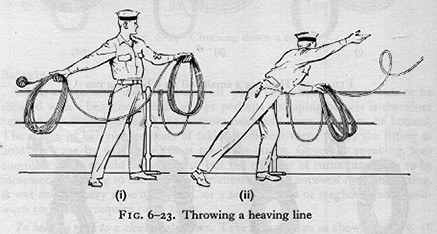
When Monkey’s Fists Go Bad

©2016Latitude 38 Media, LLC
‘Monkey’s fist’ is the name given to a knot made with three to six turns, which is tied at the end of a rope line, making one end of the line heavier and thus easier to toss. The monkey’s fist is most often used in heaving lines.
In the case of larger yachts and ships, a small line with a monkey’s fist is attached to the end of a normal dockline, a dockline that can’t be thrown ashore because it’s too heavy. Once the smaller line with the monkey’s fist is thrown ashore, the person ashore pulls in the dockline attached to it and secures it around a bollard.
In some cases, some sort of weight is placed inside the monkey’s fist, making it heavier and thus easier to throw. All sorts of things have been used as weights — stones, marbles, bolts, grapeshot, lead — you name it.
There is a proper technique to both throwing and receiving a line with a monkey’s fist. To throw such a line, you position your body sideways to where you want to throw it. You then hold most of the coils in the leading hand, and several coils and the monkey’s fist in the trailing hand. Making a half circular motion with your body, you throw with the back arm, straightening it out, and follow through with the forward arm. Getting good at throwing a heaving line with a monkey’s fist takes practice.

A month or two ago we were standing by a bollard at the Charles de Gaulle Quai in St. Barth watching a beautiful 180-ft dark-hulled yacht — which shall go unnamed — being backed by her captain toward the cement quay and next to an even larger poweryacht for a Med-tie. Manuel, from the port captain’s office, was standing at the other bollard.
The whole Med-tying process, starting with the dropping of two anchors on the other side of the harbor, takes about 15 minutes for a mega-yacht. It was quite a spectacle and drew a considerable crowd. Whatever captain of industry owned or had chartered the boat, with his wife and guests at hand, silently observed the captain and crew at work. The eight or so uniformed members of the crew attentively manned their stations, awaiting commands from their captain, fully aware of the audience.
After the captain had skillfully backed and thrustered the great yacht in position about 15 feet from the quay, he gave the order to toss the heaving lines ashore. Although no word was spoken, it was understood that Manuel would get one line and we would get the other. The deckhand throwing the weighted monkey’s fist to Manuel did an excellent job, as it flew about 15 feet past him, and was thus easily retrieved so the bigger dockline could be pulled in and secured.
All eyes were now upon another deckhand who was going to toss the heaving line in the direction of the Wanderer. It’s unclear if the line had been poorly coiled or what, but when the line with the monkey’s fist got about halfway to the quay, its forward motion abruptly halted and it splashed into the water. The silence was deafening.
The red-faced deckhand quickly pulled the dripping line back in as his humiliated crewmates looked on in shame. The captain looked on stonefaced, but if there had been a gun handy, we think he might have used it. The owner/charterer was impassive, as if the blunder was beneath him and his yacht. Fortunately, the normal wind on the beam was light, the line was thrown again, this time properly, and the yacht was secured.
As far as the Wanderer is concerned, the technique for being on the receiving end of a line with a monkey’s fist depends on how big the line is and if the monkey’s fist has a weight in the middle. If the line and fist are relatively light, and the distance it has to be thrown isn’t very great, we hold our arm out perpendicular to our body, hoping the tosser can hit our outstretched arm with the line. If the line is heavier and/or there is a weight in the fist, our technique consists of getting the hell out of the way of the line until it lands on the ground, then retrieving it.
The problem with monkey’s fists, particularly weighted ones, is that they can cause considerable injury. Robin Stout of the Redondo Beach-based Aleutian 51 Mermaid knows this all too well, for while serving as a line-handler on the yacht Nirvana going through the Panama Canal in late April, she was hit in the eye with a monkey’s fist thrown by one of the Canal workers. It wasn’t something she could have avoided.
“When the guy realized he had overthrown the line with the monkey fist, he gave it a little tug back while it was still in mid-air,” Stout recalls. “At the last second the monkey fist became like the end of a whip and hit me in the eye.”
There are not many regulations to be found on how to restrict weights of heaving lines, but at least the "Code for Safe Working Practices for Merchant Seamen" issued by the UK Maritime and Coastguard Agency, is very clear on this subject. "Vessel’s heaving lines should be constructed with a monkey’s fist at one end. To prevent personal injury, the fist should not contain any added weighting material." Obviously that’s not the way they do things in Panama.
Have you ever had an interesting monkey’s fist or heavy-line incident? If so, we’d like to hear about it.
